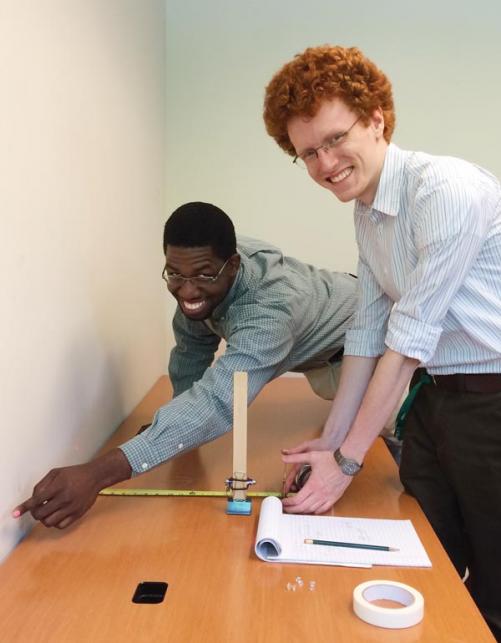Get Inspired!
Spring
2014
Special Feature
Get Inspired!
Ideas for Physics Outreach
By:SPS Staff

Make every holiday a physics holiday. Halloween is a great excuse to break out the lasers and transform a lecture hall into a creepy (and educational) experience for the public. But why not put on a wig and do some relativity demonstrations on Einstein’s birthday (don’t forget to eat pie that day, too!) and build pumpkin-tossing trebuchets on Thanksgiving, as well?
Get festiv(al). Every year, Texas A&M University holds a massive physics and engineering festival that draws thousands of kids to its campus. Graduate students, undergraduates, and faculty come together to produce more than 100 demos, an experience that energizes the department and has proven to be a valuable recruitment tool. Start small by holding a booth at a campus or community fair. Consider street fairs and arts festivals in your community, as well.
Team up with a teacher. Bringing hands-on outreach activities to a local school can be inspirational, not only for young students but for your SPS chapter as well (see Theresa Coffman’s testimonial on p. 14). After-school science clubs can provide a nice venue for building rockets or other long-term projects. Some chapters target specific underperforming and under-resourced schools and visit the same class multiple times. Others have longstanding physics road trips with dozens of stops.
Put a SOCK in it. Every year, SPS summer interns at the SPS National Office design a new Science Outreach Catalyst Kit (SOCK) full of hands-on physics activities for students of all ages. The 2013-14 kit is called “Sensors, Detectors and Meters—Oh My!” and was created in partnership with the National Institute for Standards and Technology to emphasize the importance of sensors that go beyond our touch, taste, smell, sight, and hearing capabilities. SOCKs are specifically designed to help SPS chapters kick-start or grow their outreach efforts. For information about how to get a free SPS SOCK, visit www.spsnational.org/programs/socks/.
Showcase physics with a bang. Get community members and students in other departments hooked on science with a regular showcase of demos on your campus that are open to the public. Juanita Community College has been doing this for more than a decade; their most popular demo involves smashing a cement block while it is perched on the chest of a math professor.
Take physics off campus. Engage community members in discussions about science by hosting a science café at a local restaurant, coffee shop, or bar. A science café is an informal event at which a scientist gives a short, informal talk (without slides!) to attendees in a casual environment. Another option—bring physics to the mall! The Idaho State University puts on physics demonstrations and hands-on science exhibits at a local mall, where SPS members also make liquid nitrogen ice cream. Consider programs at local libraries and museums; the University of Oregon chapter, for instance, partners with the Science Factory, a children’s museum in Eugene.
Show the stars. Does your university have an observatory, planetarium, or even small, standalone telescopes? Put on a night of stargazing for the public. The US Air Force Academy SPS chapter did this for 450 scouts, students, and teachers last year. You might not be able to recruit Miss Mississippi USA to explain how a planisphere works, like they did, but you can probably recruit an astronomy student. //
Doing outreach, both for our annual Texas A&M Physics and Engineering Festival and throughout the year at camps and auditoriums and elementary schools, has had a direct positive impact on our current students and their educations. Guided by professors, students work together on the research, concept, design, and fabrication of science demonstration experiments. Graduate students learn how to lead a team and practice explaining their science to the public; undergraduates benefit by acquiring a deep knowledge of underlying physics concepts and learning real-life skills ranging from welding and drilling to programming and soldering.” //
—Alexey Belyanin, SPS Advisor, Texas A&M chapter
